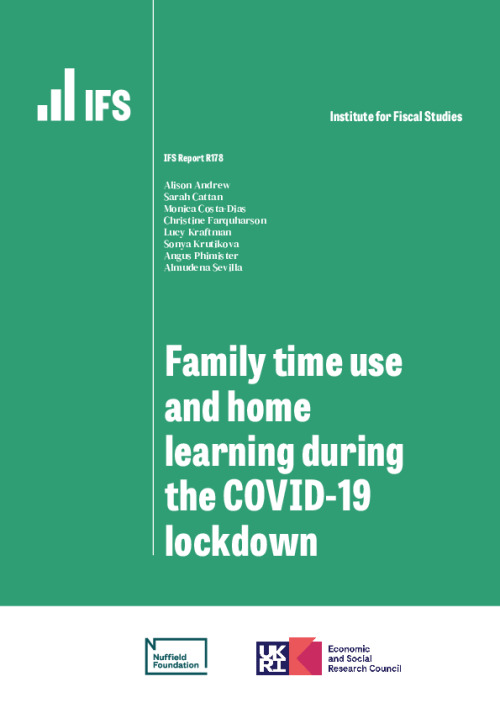The COVID-19 school closures forced children and parents to make unprecedented changes to their daily routines. Including the summer holidays, most children will have had a five-and-a-half-month break from physically attending school by the time they returned in September. There has been considerable discussion of the challenges that home learning presents for some children, and the inequalities that it could lead to (Burgess and Vignoles, 2020; Education Endowment Foundation, 2020; Eyles, Gibbons and Montebruno, 2020).
In this report, we present analysis of some of the first data on children’s lives during the lockdown and how home learning during the lockdown worked in practice. Between 29 April and 20 June 2020, we interviewed over 5,500 parents with at least one child entering Reception in September 2020 or a child in school aged 4–15. We asked parents about their employment circumstances, as well as how they and their children spent their time during a weekday. We also asked about the resources (both from their schools and at home) that school-age children had available for home learning. We collaborated with an online survey company to ensure that our respondents came from a mix of genders, regions, and social and economic backgrounds. We then reweighted our data to ensure that they are as representative as possible of families with school-aged children in England.
We start the report by providing more details about the data we use to conduct our analysis. In Chapter 3, we examine how the COVID-19 crisis has affected the economic circumstances of households with children. Then, in Chapter 4, we turn to analysing what the days looked like for parents during the lockdown, focusing on the challenges they faced when juggling work and childcare responsibilities. To put these results into perspective, we compare how parents’ time use during the lockdown differed from the pre-COVID-19 period, drawing on the 2014–15 UK Time Use Survey. The rest of the report focuses on children and their home learning experiences. In Chapter 5, we describe children’s time use and the activities that fill their learning time, again comparing these results to the pre-COVID-19 period where available. In Chapter 6, we complement this picture by examining the home learning environment and the resources children have received from their schools for home learning.
An important theme running throughout the report is that, while the COVID-19 crisis has affected all families with children, it has not affected them all equally. In almost all aspects of family life that we look at, we see important differences between households of different socio-economic status. In the concluding chapter, we reflect on these findings and their implications for the long-term impact that the unprecedented circumstances we have lived through over the past few months is likely to have for children’s well-being and learning, and inequalities therein. We end the report by drawing a few ‘lessons for next time’, as the prospect of a second wave and future lockdowns loom in the autumn.
Key findings
- COVID-19 has brought an unprecedented disruption to parents’ working lives with important implications for families’ economic circumstances. Only around half of parents who were in work in February 2020 were still doing their job in May – others had been furloughed, quit, or lost their jobs permanently. Despite the income protection provided by policies such as the furlough scheme, a third of parents report that their monthly earnings have decreased since February 2020. These reductions in resources available to spend on children and the stress that comes with job losses create significant risks for children’s well-being.
These are trying times for parents. The lockdown made parents almost entirely responsible for childcare, leaving little time for leisure. During the lockdown, both mothers and fathers were doing some childcare during an extra four hours each day. In 2014, some 70% of parents reported having leisure time at around 7pm, whereas during lockdown only 40% did. This left very little slack in parents’ days, which could impair on parental well-being and negatively affect children’s welfare.
- Primary and secondary school children spent an average of four and a half hours a day on home learning. This includes time spent on online classes, other school work, private tutoring and other educational activities. This represents a 25% and 30% reduction in pre-COVID-19 learning time among primary and secondary school children, respectively.
- Socio-economic gaps in learning time during the lockdown are large and larger than before the lockdown, especially for primary school children. Before the lockdown, learning time was fairly homogeneous among primary school children, but this changed during the lockdown: the richest third of primary school children spent about four and half hours per week more on learning than the poorest third of primary school children. Among secondary school children, there was a gap of 45 minutes a day in learning time between the richest and the poorest third of children before the lockdown. This gap is now 15 minutes larger.
- With home learning implemented suddenly and with little national or local guidance, schools offered dramatically different packages of support to their pupils. Around half of primary schools, and nearly 60% of secondary schools, offered some active learning materials, such as online classes or online chats. But these resources were 37% (24%) more likely to be provided to the richest third of primary (secondary) school children than to the poorest third.
- Differences in schools’ home learning packages are magnified by different resources at home. Around one in eight children were either using a phone or had no device to access online schooling resources. Of even more concern, 22% of primary school children and 10% of those in secondary school did not have access to a dedicated study space at home.
- COVID-19 is likely to exacerbate inequalities in children’s outcomes. Inequalities in learning time and learning resources during the lockdown will be compounded by the fact that COVID-19 has caused children to lose the protective and safeguarding environment of schools. In these conditions, inequalities in family circumstances and home environments are likely to have even deeper consequences for inequalities in children’s attainment and well-being than they would have otherwise.
- Many of the challenges to home learning – such as a lack of space at home – are difficult for policy to address. This makes it even more important that policymakers do act where they can to reduce inequalities and improve the home learning experience. There are potentially enormous benefits to developing and sharing resources across schools (as the Oak National Academy is doing). These will both improve equity in access to home learning and free up teachers’ time for providing more individualised instruction and supporting children in difficulty.















